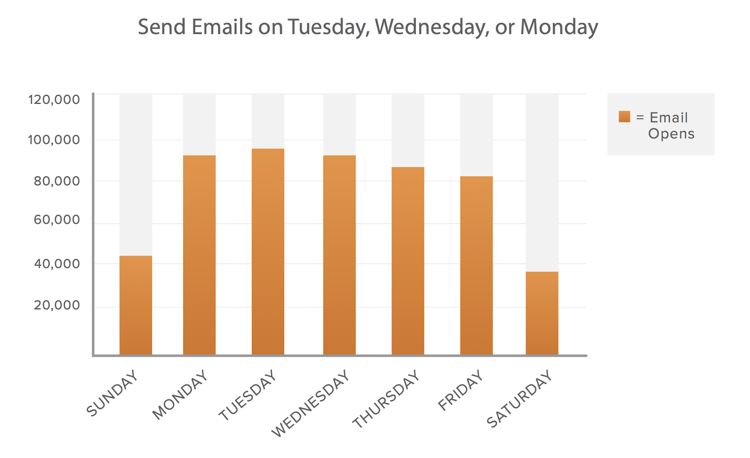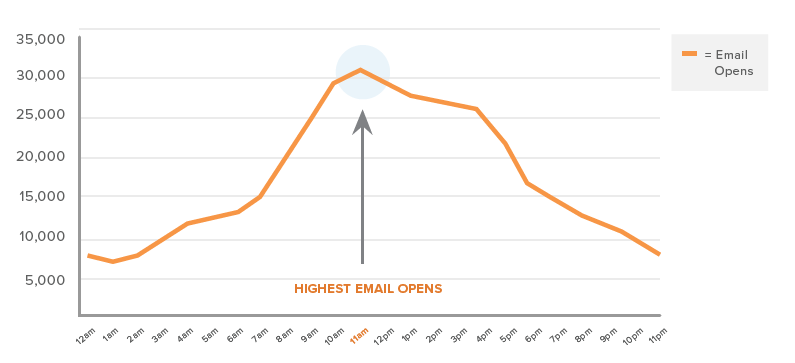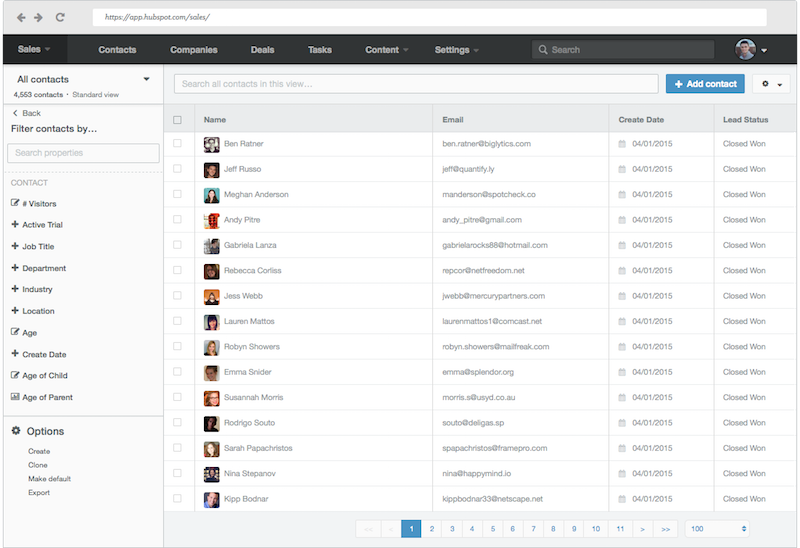How To Write A Sales Email People Want To Respond To
“To open, or not to open?”
The question running through everyone’s mind each time they skim their email inbox.
And if that someone is one of your potential customers, the answer to that question could become the difference in your paycheck. So, naturally, you want the answer to be “open.”
Of course this leads to the next dilemma — your recipients wondering, “To respond, or not to respond?”
And the answer to this question also has the power to change the figures of your paycheck. So, naturally, you want the answer to be “respond.”
But, how do you get your sales email recipients to openandrespond? Below we'll review the steps to writing and sending an effective sales email so your recipients do just that.
This guide will cover the steps to writing the perfect sales email, great examples of sales emails, when you should send your emails, and strategies to improve your response rates.
How to Write the Perfect Sales Email
- Include a subject line
- Write a strong opening line
- Include helpful body copy
- Add a CTA in the closing copy
- Add a professional signature
Let’s dive into each of these five components. The suggestions below come from real results seen by HubSpot's sales team andJeff Hoffman'ssales workshops.
1. Subject Line
Keep your sales email subject line short and enticing. Remember, the goal is to pique the interest of your reader, not to sound like a used-car salesman. Here are some examples used by HubSpot sales reps:
- Jerry recommended I get in touch.
- Ideas for [thing that's important to them]
- Question about [recent trigger event].
- Question about [goal they have].
- Thoughts about [title of blog post].
- Have you considered [thought / recommendation]?
Additionally, remember to avoid “spammy” words in your subject lines at all costs. Here are some examples:
|
|
|
Pro Tip: A/B Test Your Subject Lines
Take a subset of your prospect list, ensuring it hits a minimum of 50-100 emails to achieve statistical significance. Then split the list into two subgroups. Now send these subgroups an email with the same content, but with different subject lines.
After collecting results, you should choose the subject line that yields a higher open rate to send to the rest of our list.
Hint: You should aim to achieve a minimum open rate of 30% to 50%.
2. Opening Line
When it comes to your sales email's opening line, avoid beginning with, “Hi my name is …”
Instead, start with something more impactful by talking to your reader. Here are some examples HubSpot's sales team has seen success with:
- I noticed you ...
- [Mutual connection] mentioned ...
- I saw that we both ...
- I loved your post on ...
- Congratulations on ...
3. Body Copy
Your sales email's body copy should convey value by connecting your business to your prospect. Avoid generic value propositions such as, “We help web marketing firms increase their lead generation by 400% and effortlessly prove ROI to their clients.”
Ask questions that align the research you've conducted with your prospect’s goals. Here are some examples:
|
4. Closing
接近你的销售强劲的电子邮件给收件人s a clear path to action. Try ending with one of the following questions to prompt a definitive response:
- Do you have time on your calendar to discuss?
- Have you given any additional thought to the proposal?
- Let me know what makes sense as a next step, if any?
- Do you have ten minutes to catch up tomorrow?
- Does it make sense for us to talk? If not, who is the best person for me to talk to?
- Do you have any more questions I can clear up?
- Are you available for a 30-minute call on [date and time]?
- Let me know if [business goal] is a priority for you now, or perhaps sometime in the future.
- If you aren’t interested, do I have your permission to close your file?
5. Signature
A sales email signature should not be a distraction — nor should it be a source of cliché inspiration. Instead, stick to these email signature guidelines:
|
Sales Email Templates
Below we’ve included foursales email templatesthat have proven to be successful for HubSpot sales reps and other industry leaders for your review.
Download25 sales email templates proven to help you boost conversions.
Business Value
Hi [First Name]
I’ve worked with your peers in [industry or position] for X years now. One of the key challenges they struggle with is [challenge].
Over the past year we’ve helped Y companies to achieve [business goal], resulting in Z [revenue added, money saved, productivity increased].
If this issue resonates with you too, let’s schedule a quick call. I have some ideas that may help.
Best,
[Name]


Company Announcement
[First Name],
I work in [targeted industry] and I noticed that you recently [company action] at [company name].
From my experience, [business issue] usually becomes a priority when that happens. I thought you might be interested in learning how we helped [similar firm] succeed in their new direction without any hiccups.
If you’d like to chat, let’s set up a call. Are you free [days and times]? Let me know.
Regards,
[Name]
P.S. If you’re not the right person to speak with, who do you recommend I talk to?


Your approach to [challenge]
Hi [First Name],
The article you shared on LinkedIn yesterday addresses a challenge that I’ve heard two other sales directors mention this week. I would love to hear your unique perspective on the issue.
We help sales execs improve their reps' success with tools that use a similar approach. Do you have 5 minutes to speak on Wednesday or Thursday afternoon this week?
Talk soon,
[Name]


Thought you might find this helpful
[First Name]
I saw your recent announcement this week about [news]. It got me thinking… I found this article on [topic] that I think you could use as you and your team move forward.
Hope you find it helpful. Let me know if you’d like to chat more about it offline.
Best of luck,
[Name]


When To Send a Sales Email
A HubSpot Study
HubSpot conducted a study over the course of 10-months — based on over 20 million emails — to determine the ideal time to send your sales email.
The volume of email opens each day of the week was used to determine which day correlates with the highest number of email opens.
Tuesday was found to be the best day of the week to send an email with 20% more opens than average. Monday and Wednesday tied for second with 18% higher email opens, followed by Thursday at 15% and Friday at 8%.

Time of day was also considered — 11 AM EST was shown to provide the highest chance of receiving a response to a sales email. Taking Saturday and Sunday out of the picture, the highest email opens on the weekday fall between 10 AM and 12 PM, with the peak of opens occurring at 11 AM.

Sales Email Follow Up Strategies
Sales email sent.
Phew, the hardest part is over ... right?
Not really — that's because80% of sales require五个跟进之前一个客户说“好啊!”
So, what can you do if you know your recipients are opening your emails but aren't responding? And how to you earn their trust?
We’ve outlined a 3-step strategy explaining what to do after you send your initial sales email to effectively follow up and engage with your prospects. These steps include:
1. Measure engagement, call fast, and open with context.
If you see a prospect engaging with your sales emails on multiple occasions, opening them many times, or clicking on links and attachments, you can use that as a measure of interest. The more interested a prospect, the higher probability you have of engaging with them.
You can track and measure email engagement withHubSpot Sales Software也允许您轻松的角色lize email templates and reports, create an automatically-logged call queue, learn how prospects engage with content through document sending/ tracking, and follow up with highly targeted and timed emails with the help of email automation.
Once you determine a contact is engaging with your emails, you can reach out. Here's an example of something you could say to get the ball rolling:
Pro Tip: Call Fast and Open with Context
[Salesperson]: "Hey Josh, this is Tim over at X Company ... am I catching you at an alright time?"
[Prospect]: "Wow, Tim, I was actually just reviewing the email you sent over earlier. Great timing."
[Salesperson]: “Excellent, I will be brief. I noticed you were checking out some of the information around the link I sent on improving your sales team performance. Wanted to circle back and see if there was anything you had questions on, or if there was further information I could point you towards that would be helpful …”
Free Tool: HubSpot CRM
Take control of your sales process with HubSpot CRM, a flexible, intuitive solution for managing your prospects and sales pipeline.

2. Track trigger events, follow up fast, and open with context.
Rather than following up with prospects randomly, you can use trigger events to create relevant and personalized sales emails that recipients are more likely to respond to.
Examples of trigger events include product launches, vacations, birthdays, exceeding Q4 earning expectations, or getting a Yorkshire Terrier puppy. You can use various tools, such as Google Alerts or LinkedIn, to keep track of trigger events.
Google Alerts
You can have Google Alerts send you notifications whenever a specific prospect, company, product, or industry buzz word is mentioned on the web.
Use LinkedIn's "Mentioned in the News" feature or find a group relevant to your prospect — or their company or industry — and use relevant resources, material, or information to follow up.
3. Add value at regular intervals until the prospect is ready to talk business.
Sometimes you'll catch a prospect at a bad time. Maybe they’re going on sabbatical for a month or simply focused on other priorities. But this doesn’t mean "game over" for you. In fact, it’s a unique opportunity to demonstrate your value.
Here are five examples of how you can prove your value to prospects:
- Share your prospects' company, products, or content on your social media accounts or other mediums.
- Mention them in an article, blog, or offer to promote them.
- Share helpful articles, advice, or books to help them solve an issue they may be encountering.
- Introduce them to someone they might find valuable such as a thought leader in their industry or a potential candidate for one of their position openings.
- Provide them with insightful feedback on their products and content.
Open And Respond
That’s what your prospects will be doing now that we’ve covered the essentials to crafting a strong sales email.
Remember the steps to writing sales emails to allow for the greatest chance of an increase in your response rate — because that response rate is directly related to your conversions, sales,andyour paycheck. By writing and sending effective sales emails at the right time, using effective tactics that make your recipients want to write back, and knowing how to follow up with those recipients, you'll see your response rate and conversions increase. So, use the email templates and examples we reviewed to begin boosting your sales today.